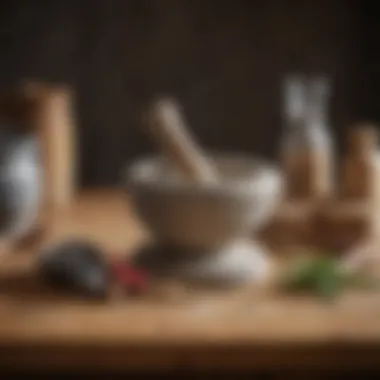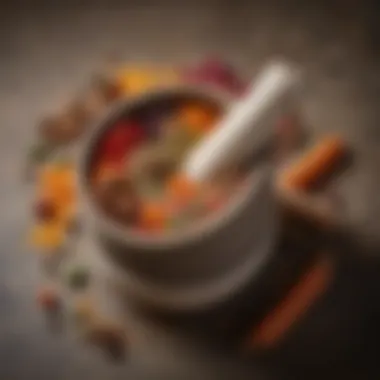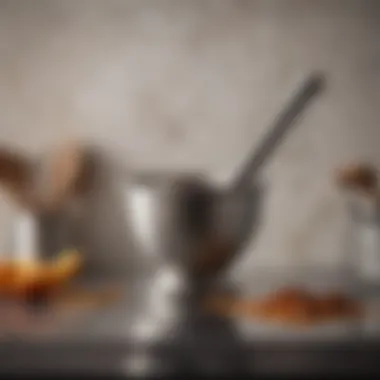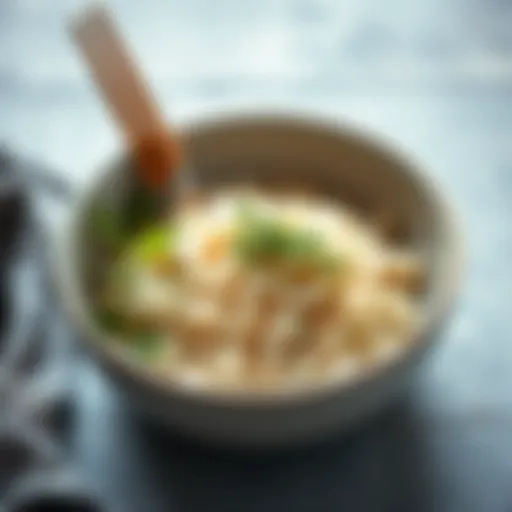Choosing the Best Material for Your Mortar and Pestle


Intro
Choosing the right material for a mortar and pestle is a vital aspect for anyone passionate about cooking. This tool plays an essential role in food preparation, transforming whole spices and fresh herbs into flavorful pastes and powders. The material of the mortar and pestle can greatly influence the grinding experience. Various options exist, each bringing unique characteristics that can enhance or hinder your culinary efforts. By understanding these materials, you can elevate your kitchen skills and achieve better results in yourrecipes.
The objective of this article is to provide a thorough analysis of materials such as stone, ceramic, stainless steel, and wood. Each type has its own advantages and drawbacks. Through this exploration, culinary enthusiasts will learn how these choices impact grinding efficiency, flavor infusion, and overall durability of the tools.
Such insights are paramount as they not only guide the selection process but also explain how the right material can affect the essence of your dishes. This discussion offers a roadmap to making informed choices rather than simply following trends or brand recommendations.
Prolusion to Mortar and Pestle
Understanding the significance of a mortar and pestle begins with recognizing its role as an essential tool in cuisine. For centuries, this ancient apparatus has served as a means to grind and crush various ingredients, acting as a bridge between raw materials and culinary innovation. The mortar provides a sturdy base, while the pestle acts as the mechanism of transformation. Together, they unleash flavors and textures that other tools simply cannot replicate.
Utilizing a mortar and pestle can offer a deeper connection to the food preparation process. This tactile experience allows cooks to engage more fully with their ingredients. The act of grinding isn’t merely a method; it’s an exploration of flavors, aromas, and traditions. Culinary enthusiasts find that this technique can elevate their dishes significantly. Whether it’s breaking down spices for a curry or crushing fresh herbs for a pesto, the advantages of using a mortar and pestle are substantial.
The choice of material in crafting this tool is paramount. Different materials yield various results, affect efficiency, and even influence the taste of the food. Therefore, understanding the materials used in making mortars and pestles is essential for making an informed choice. This article delves into how selection impacts not only the grinding efficiency and user experience but also flavor retention in the culinary arts.
A well-selected material can transform the mundane task of grinding into a precise art form, enhancing both taste and texture profoundly.
Importance of Material Selection
Selecting the right material for a mortar and pestle is vital because it profoundly affects the outcome of food preparation. Each material brings unique properties that influence various aspects of the grinding process. Understanding these nuances ensures that culinary enthusiasts can make informed choices tailored to their specific needs.
Impact on Grinding Efficiency
When it comes to grinding, the efficiency of the tool is often dictated by the material properties. Stone options like granite and marble have a rough surface that allows for better friction and grinding action. Spices and herbs tend to break down more effectively against these surfaces, resulting in a finer texture. In contrast, materials such as metal may not provide the same level of friction, leading to less effective grinding.
The hardness of the material also affects how well it can handle tough ingredients. For example, a granite mortar can withstand the pressure of tough nuts or whole spices without cracking. In contrast, ceramic options may chip or break under significant strain, particularly when dealing with harder substances.
Furthermore, different materials respond differently to the force applied. A heavier mortar can be beneficial, as it provides stability during use, preventing unwanted movement. Therefore, when considering efficiency, the weight, texture, and hardness of the material are key elements that should not be overlooked.
Influence on Flavor Retention
Another crucial aspect to consider is how material influences flavor retention. Some materials are more reactive than others, which can affect the taste of the ingredients being prepared. For example, metal mortars, while durable, can impart a metallic taste to sensitive herbs and spices. This is not only undesirable but can alter the overall flavor profile of a dish.
On the other hand, non-reactive materials like ceramics or high-quality stone do not affect the flavor of the ingredients. They allow flavor compounds to remain intact, enabling the cook to extract the best potential from every spice. This characteristic is particularly important for dishes that rely heavily on precise flavors, such as certain sauces or seasonings.
In summary, choosing the right material influences both the grinding efficiency and the preservation of flavors. Paying attention to these details enhances the cooking experience and outcomes. Anyone serious about cooking will find that the material of the mortar and pestle can make a significant difference in their culinary endeavors.
Types of Materials
Choosing the right material for a mortar and pestle plays a crucial role in achieving culinary excellence. Each material possesses unique properties, determining its suitability for different tasks. Understanding the characteristics of each type helps in making informed decisions that enhance the overall grinding experience.
Stone Mortar and Pestles
Stone mortar and pestles are traditionally favored for their durability and effectiveness. These tools can handle a variety of ingredients, making them versatile for many culinary tasks. The following are key types of stone mortar and pestles.
Granite
Granite is a popular choice when selecting a stone mortar and pestle. It is well-known for its durability, able to withstand heavy use without cracking or chipping. The textured surface of granite provides an excellent grip, enabling efficient grinding of ingredients.
One major advantage of granite is its heavy weight. This stability allows for effective processing of tough spices and herbs without needing to exert excessive force.
However, the porosity of granite can absorb flavors and odors over time. To prevent this, it is essential to clean and season it properly.
Marble
Marble also stands out as a luxurious option for mortar and pestles. It has a smooth surface which makes grinding easier. Its aesthetic appeal adds a touch of elegance to any kitchen setup.
Despite its visual charm, marble is not as durable as granite. It can chip or crack more easily under pressure. This characteristic makes it less favorable for those who frequently grind hard ingredients.
Nonetheless, marble is less porous than granite, meaning it retains less odor and flavor, making it ideal for culinary enthusiastists who often switch between different spices.
Lava Stone
Lava stone, or volcanic stone, is a unique and increasingly popular choice. Its rough surface enhances grinding efficiency, making it easy to crush tough spices.
This type of stone is different because it is lightweight. This feature makes it easier to handle, especially for light food preparation tasks. However, its lighter weight might not provide the same stability for heavy grinding compared to granite.
Lava stone's natural texture can also lead to an increased retention of flavors, which could be beneficial or detrimental depending on how it is used.
Ceramic Mortar and Pestles
Ceramic mortar and pestles offer a different set of characteristics. They are generally favored for their aesthetic appeal and their non-reactive surfaces. Here are the primary types of ceramic mortar and pestles.
Porcelain


Porcelain is an elegant choice due to its smooth surface. This quality allows for easy grinding, especially for softer ingredients like herbs and spices. Its non-reactive nature means it won't alter the flavor of food.
However, porcelain can be quite fragile. It is more susceptible to chipping or breaking compared to stone alternatives. Therefore, careful handling is necessary during use.
Earthenware
Earthenware offers a rustic and traditional look. It is often more affordable than other ceramic options. While it has a charming aesthetic, earthenware can be prone to absorption, which may lead to odors.
Despite this, earthenware can be suitable for casual food enthusiasts who prefer simplicity and lower maintenance.
Stoneware
Stoneware provides a balance between durability and usability. It is thicker than other ceramics, giving it a robust feel. Stoneware is less porous than earthenware, reducing the likelihood of flavor absorption.
However, like porcelain, it is still subject to chipping if dropped. This material is ideal for those who seek functionality combined with style.
Metal Mortar and Pestles
Metal mortar and pestles bring modernity and efficiency into the kitchen. Materials like stainless steel and aluminum serve distinct purposes with their own advantages.
Stainless Steel
Stainless steel is highly regarded for its resistance to corrosion and its sleek look. It is non-porous, meaning it does not absorb flavors or odors from previously ground ingredients. This feature ensures a pure grinding experience.
One downside is that stainless steel can retain heat from the grinding process, which may not be ideal for sensitive ingredients. Additionally, it can create noise during use, which could be a concern for some cooks.
Aluminum
Aluminum is lightweight and offers easy handling. It is also resistant to rust, which contributes to its longevity. However, aluminum does not have the same non-reactive quality as stainless steel. It can interact with certain acidic ingredients, altering flavors.
Despite these drawbacks, aluminum mortar and pestles are often more affordable and thus appealing to entry-level cooking enthusiasts.
Wood Mortar and Pestles
Wooden mortar and pestles are cherished for their natural appearance and traditional use in cooking. Different types of wood deliver unique benefits.
Teak
Teak is prized for its durability and water resistance. It does not warp easily, making it suitable for a variety of food preparation tasks. The beauty of teak wood also nurtures a warm look in the kitchen.
However, teak can absorb odors and flavors over time. Therefore, regular cleaning and maintenance are crucial to preserve its quality.
Maple
Maple offers a smooth surface that is gentle on spices and herbs; it can effectively grind without overly damaging the ingredients. It is relatively lightweight compared to other wood types, making it easy to use.
However, like teak, maple can retain flavors. Frequent cleaning may be needed to ensure a neutral taste for different food preparations.
Bamboo
Bamboo is an eco-friendly choice; it grows quickly and is sustainable. It is lightweight and has natural antibacterial properties, making it hygienic for food preparation.
Nonetheless, bamboo can wear down faster than harder woods. Its softer structure may not be ideal for grinding tougher spices, but it is excellent for herbs and softer ingredients.
Advantages of Different Materials
When it comes to mortar and pestle sets, the material chosen plays a crucial role in determining the effectiveness of the tool. Each material brings specific benefits that cater to various culinary needs, influencing both the performance and the user experience. An understanding of these advantages can help culinary enthusiasts select the best option based on their cooking habits and ingredient types.
Granite Mortars
Durability
Granite mortars are highly durable, which is a significant factor to consider. They can withstand heavy usage and resist wear over time. A granite mortar will not chip or crack easily, even when grinding tough spices or herbs. This durability makes granite an attractive choice for serious cooks who seek longevity in their kitchen tools. With such resilience, granite mortars often become a family kitchen staple, passed down through generations.
Texture
The texture of granite offers practical benefits too. With its rough surface, it enhances the grinding process. The peaks and valleys of the material catch and crush herbs and spices effectively, allowing for a more efficient extraction of flavors. This feature also contributes to a unique quality in the final product, bringing out richer aromas and tastes in culinary preparations. As a result, many culinary experts prefer granite for its ability to enhance flavor extraction in a way smoother materials cannot.
Ceramic Options
Non-reactive Surfaces
Ceramic mortar and pestles offer a non-reactive surface that is ideal for grinding. This quality ensures that flavors remain pure, as there is no chemical reaction between the ceramic material and the ingredients. It's particularly beneficial for delicate spices, which can be affected by more reactive materials. The safety of non-reactive surfaces provides confidence for cooks dealing with high-grade or specialty ingredients.
Ease of Cleaning


Cleaning is another strong point for ceramic options. Their smooth surface means less residue gets trapped, making them easier to wipe down after use. Unlike other materials which may be porous, ceramic does not retain odors or flavors. This ease of cleaning is appealing to cooks who value both hygiene and convenience in the kitchen. However, while convenience is a great advantage, one must still handle ceramic carefully to avoid chipping or cracking.
Stainless Steel
Resistance to Corrosion
One of the standout advantages of stainless steel mortars is their resistance to corrosion. This characteristic ensures that the mortar does not rust or degrade with moisture, making it a reliable choice for wet or oily ingredients. This durability is particularly advantageous in busy kitchens where tools see a lot of varied use. Users can focus on their culinary creativity without worrying about the integrity of their equipment.
Modern Aesthetic
In addition to their functional benefits, stainless steel mortars offer a modern aesthetic that appeals to many cooks. Their sleek, shiny finish adds a contemporary touch to kitchen decor. For those who appreciate not only functionality but also design, stainless steel can be a fitting choice that complements various kitchen styles. This aesthetic aspect, combined with practicality, ensures that stainless steel remains a favorite among home cooks.
Wooden Pestles
Traditional Use
Wooden pestles have served in kitchens for centuries. Their traditional use connects many cooks to their culinary heritage. This bond can enhance the cooking experience, particularly for those who enjoy authentic methods. Wooden pestles are typically lightweight, making them easy to handle for extended periods. Their classic appeal makes them a great choice for those who appreciate age-old techniques and a sense of history in their cooking.
Natural Look
The natural look of wood provides an aesthetic warmth that is inviting in any kitchen. Each wooden pestle has unique grains and colors, offering an individual touch that many find appealing. The craftsmanship involved in creating wooden tools can add value to the culinary routine. While beautiful, wooden pestles require maintenance to preserve their appearance and functionality, as they can absorb odors and flavors over time.
Choosing the right material can significantly impact the cooking experience and the quality of the dishes produced.
These advantages highlight how various materials can influence not only the practical aspects of using a mortar and pestle but also the overall enjoyment in the kitchen. Understanding these pros can guide chefs and enthusiasts alike in making informed choices tailored to their culinary practices.
Drawbacks of Common Materials
Understanding the drawbacks of various materials used in mortar and pestle sets is crucial for anyone looking to make an informed choice. Each material, though having its strengths, also presents unique challenges. These challenges can affect the usability, longevity, and even the flavor profile of the ingredients being ground. This section explores significant concerns associated with stone, ceramic, stainless steel, and wooden pestles, helping you to weigh their positives against their negatives.
Challenges with Stone
Weight
One of the first aspects to consider with stone mortar and pestle sets is their weight. Heftiness is a characteristic feature of stone grinders, particularly granite options. This weight can provide stability during grinding, which in turn enhances the grinding efficiency. However, it also makes them less portable. Carrying a heavy stone set becomes cumbersome. Weight may deter casual users from integrating this type of mortar into everyday cooking, limiting its popularity among those who prioritize convenience in the kitchen.
Porosity
Moreover, stone materials often display significant porosity. This feature can be a double-edged sword. While porosity allows for better texture during grinding, it also presents some issues. Ingredients can seep into pores, potentially causing flavor carryover. Over time, you might observe that your fresh spices take on residual flavors from previous sessions, compromising the purity of your culinary creations. Understanding the implications of porosity is essential for maintaining the integrity of your ingredients, bringing potential problems to the forefront.
Ceramic Limitations
Fragility
Ceramic mortar and pestle sets are known for their aesthetic appeal. However, fragility is a major concern with these types. A ceramic vessel can break quite easily with a heavy-handed approach, which is commonly encountered in the kitchen. This lack of durability could influence whether someone opts for this material for frequent use. While it performs well for delicate tasks, the fear of breaking often overshadows the advantages.
Chipping Risks
Similar to fragility, another disadvantage is the risk of chipping. Regular contact with hard spices or nuts can lead to small chips in the surface. These can affect the efficiency of grinding, as jagged edges do not optimally support the grinding process. Even worse, chipped edges can sometimes flake into your food. Therefore, while the beauty of ceramics may draw you in, be aware of its practical limitations and the necessity for careful handling.
Stainless Steel Concerns
Heat Retention
For those who consider stainless steel models, heat retention is a specific issue to contemplate. Stainless steel conducts heat effectively. When grinding spices, the process can produce heat, altering the flavor and aroma of delicate ingredients. This heat might even evaporate essential oils, leading to a less potent final product. For culinary enthusiasts who focus heavily on preserving the integrity of spices, this is a notable factor during material selection.
Noise
In addition to heat, the noise produced during grinding can be a problem. Stainless steel sets create more sound than models made from softer materials like wood or ceramic. This might not seem like a significant issue initially but can become problematic in quiet environments. If you have a strong preference for an unobtrusive cooking atmosphere, the loud operation of stainless steel models could be a deterrent.
Wooden Pestles Issues
Absorption of Odors
Wooden mortar and pestle sets feature a natural aesthetic, but they have their own set of complications. One of the primary concerns here is absorption of odors. Wood is porous and can soak up strong scents from spices, leading to flavor contamination. When you move from grinding garlic to cardamom, the residual odor from previous sessions might linger. This can affect the purity of your tastes and can be a significant inconvenience for avid cooks who value distinct flavors.
Maintenance
Furthermore, wooden sets require particular attention in terms of maintenance. Unlike stone or stainless steel, wood can suffer from warping and cracking if not properly cared for. Regular oiling is recommended to keep the wood in optimal condition, adding an extra step to your kitchen routine. This level of upkeep might be a deterrent for those who prefer a no-fuss approach to kitchen gadgets.
Choosing the Right Material for Your Needs
Selecting the ideal material for your mortar and pestle is critical. Materials dictate how well you can crush, grind, and mix your ingredients. Each type of material presents its unique characteristics and affects different aspects of food preparation. Knowing what works best for your cooking style is vital to enhancing your culinary experience.
Types of Ingredients


Spices
Spices vary significantly in texture and density, which influences the method of grinding. Many spices have strong flavors that benefit from thorough grinding, releasing essential oils and enhancing taste. A granite mortar is often recommended due to its tough surface suitable for tougher spices like peppercorns and cardamom. The coarseness of the granite aids in achieving a fine consistency without undue effort. However, some spices release oils that can stick to porous materials, potentially affecting flavor in future uses.
Herbs
Herbs are generally more delicate than spices, yet their aromatic properties are enhanced through proper grinding. Fresh herbs like basil or mint release distinctive flavors when crushed, making the choice of material essential. A ceramic mortar may be best here as it offers a non-reactive surface, preserving the delicate essential oils without interference. Nevertheless, care should be taken with harder herbs like rosemary, as the material may not withstand the intensity of the grinding.
Nuts
When it comes to nuts, the task often involves creating a paste or crushed pieces for cooking and baking. Nuts can be oil-rich and may cause some materials to absorb flavors. A heavy-duty stainless steel mortar excels here, providing the necessary strength and durability for effective grinding. However, one must consider ease of cleaning, since sticky residues can remain. A wooden mortar may also work but bears risks of flavor transfer unless well maintained.
Frequency of Use
Occasional Cooking
For occasional cooks, a versatile mortar made from ceramic or wood can be sufficient. These materials are often lighter, making them easier to handle, yet they may not perform as well over time with frequent use. Occasional use minimizes the impact of potential maintenance issues, such as the need for careful cleaning or seasoning. However, they might not provide the grinding efficiency desired by serious food enthusiasts.
Daily Culinary Practices
Those who cook daily should invest in a robust mortar and pestle. A granite or stainless steel version would benefit these users by offering durability and capability. Daily use demands a material that can withstand rigorous grinding without showing signs of wear or damage. While the initial cost may be higher, the long-term benefits of reliability in daily cooking tasks justify it. Heavy materials provide stability, ensuring the mortar remains steadfast during use, which is crucial for consistent results.
Skill Level
Beginner
For beginners in the kitchen, a user-friendly and lightweight mortar is typically advisable. Ceramic options, due to their accessibility in terms of handling and maintenance, can serve as a good starter choice. It allows new cooks to learn techniques without being overwhelmed. However, beginners may struggle with less durable materials showing wear over time if misused or not cared for adequately.
Experienced Cook
Experienced cooks are likely to benefit from high-quality materials like granite or stainless steel. These materials support advanced culinary techniques and provide the structure needed for heavier grinding tasks. Moreover, such mortars often come with better design ergonomics, enhancing ease of use. Yet, an experienced cook must also be aware of the material’s specifics—like weight and maintenance—to ensure optimal performance and longevity.
Maintenance and Care
Maintaining a mortar and pestle is key for prolonging its lifespan and ensuring optimal performance in the kitchen. Proper care can enhance the grinding experience and preserve the integrity of the materials used. This section will cover crucial aspects of maintenance, emphasizing cleaning techniques and seasoning recommendations.
Cleaning Techniques
Hand Washing
Hand washing a mortar and pestle is essential and should be the preferred method for cleaning. This technique involves gently scrubbing with warm soapy water and a soft sponge. One key characteristic is that it prevents rough wear.
Hand washing is beneficial because it minimizes exposure to harsh detergents that might affect the material's quality. For instance, ceramics can become porous and harbor bacteria if not cleaned correctly. The unique feature of this method is the ability to control the cleaning process, ensuring every nook and cranny is properly addressed. However, it may take more time compared to machine washing.
Avoiding Scratches
Preventing scratches on your mortar and pestle is crucial for maintaining its functionality and aesthetic. A common approach is to use utensils made from soft materials when grinding. The importance of avoiding scratches also extends to the cleaning process.
Using abrasive scrubbers can significantly degrade the surface, making it less effective for grinding. The unique feature here is the attention to the tools used, promoting longer-term durability. While it may require being cautious, preserving the surface means better flavor retention and easier cleaning. This maintenance choice is especially pertinent for stone and ceramic materials that are prone to surface damage.
Seasoning Recommendations
For Wooden Pestles
Seasoning wooden pestles is an important practice to enhance their longevity and functionality. This process typically involves rubbing the surface with food-safe oil, such as mineral or linseed oil. This helps create a protective layer that not only preserves the wood but also provides a smoother grinding experience. One key characteristic is that seasoned wood resists absorption of odors and flavors from past ingredients.
This step is beneficial because it prevents cracking and splintering, which could result from dehydration. The unique feature of this practice is its simplicity and effectiveness. However, it requires periodic reapplication, so users must commit to regular maintenance to sustain the benefits over time.
For Stone Mortars
Seasoning stone mortars can be less common than with wood, but it still has its place. This may include grinding raw rice or salt to create a smooth interior surface. The key characteristic here is the preparation of the mortar for food use. This ensures that any abrasiveness is removed and can enhance the grinding results.
It is beneficial as it creates an ideal surface for grinding spices and herbs, leading to more efficient food preparation. The unique aspect of this method is that it effectively removes any residue that previously might have affected taste or consistency. Unlike with wood, this does not typically entail regular maintenance, but rather an initial prep step.
Final Note: Without proper maintenance and care, even the best mortar and pestle can lose its effectiveness over time. A routine of cleaning and proper seasoning ensures that these tools remain reliable companions in any culinary endeavor.
End
In this article, we have meticulously examined the various materials available for mortar and pestle sets. The selection of the ideal material is not merely a matter of personal preference; it significantly influences the culinary experience, from grinding spices to preparing pastes. Each material offers distinct characteristics and benefits that cater to different cooking habits and needs.
Stone options, like granite and marble, provide strength and durability, making them suitable for heavy-duty tasks. Ceramic is valued for its non-reactive nature, while stainless steel brings modern aesthetics with impressive longevity. Wooden choices offer a traditional touch but require more care to maintain their quality.
Choosing the right material involves considering factors such as the type of ingredients you typically handle and how often you use the mortar and pestle. It is crucial to assess the maintenance required for each type, as this can affect not only the tool's lifespan but also the flavors that may linger from previous uses.
"The essence of culinary excellence relies significantly on the tools one employs. Material choice in mortar and pestle is a silent yet mighty decision."
Making an informed decision helps in achieving optimal grinding efficiency, enhances flavor retention in your ingredients, and ultimately contributes to the quality of the dishes you prepare.
By understanding the intricacies involved in selecting materials, you can elevate your cooking game. The right mortar and pestle set appears as a humble kitchen tool, but it plays a significant role in transforming basic ingredients into culinary masterpieces.
As we conclude this exploration, it is clear that the consideration of various materials shapes not only the functionality of these tools but also enriches the overall cooking experience.















